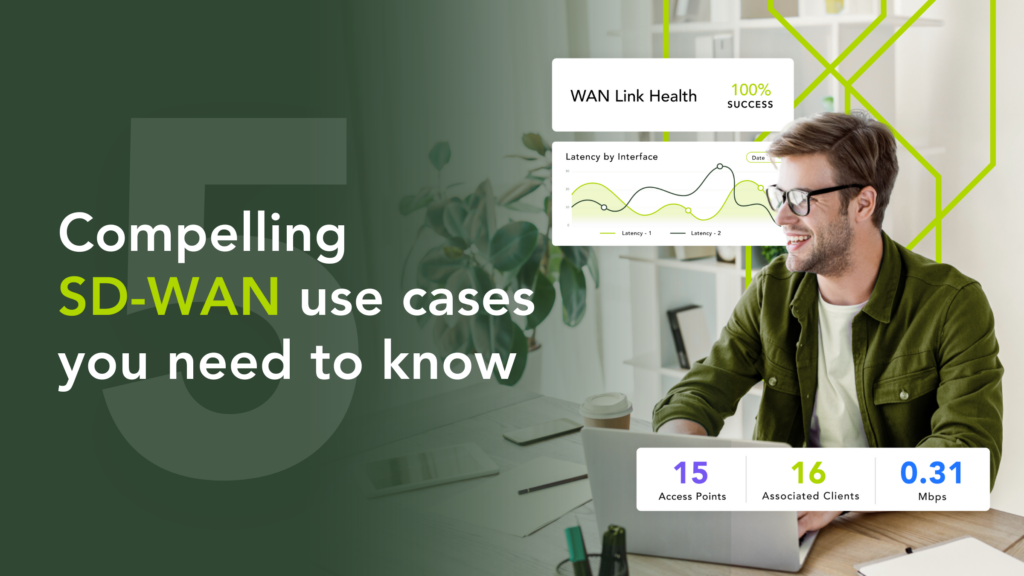More organizations are turning to the cloud to increase agility and reduce costs. As cloud adoption grows, so does the need for secure networking solutions. That’s where software-defined wide area networking (SD-WAN) solutions come in.
SD-WAN simplifies networking and improves connectivity, but it also brings unique security challenges. In this blog, we’ll explore the importance of security and best practices to protect your SD-WAN network.
What Is SD-WAN?
SD-WAN solutions use software to abstract a business’s networking infrastructure. It uses a centralized controller to manage and monitor network traffic. The SD-WAN controller allows businesses to prioritize and route traffic based on application requirements and network conditions.
With solutions such as Navigator SD-WAN, businesses gain better application performance and user experience, particularly for cloud-based applications. Since SD-WAN traffic is routed over multiple transport methods, such as MPLS, broadband internet, and LTE, businesses can reduce connectivity costs.
SD-WAN also enables businesses to implement policies across large-scale environments from a centralized platform. Overall, SD-WAN simplifies management for wide area network (WAN) connections between different locations, including branch offices, data centers, and cloud-based applications.

Traditional Networks vs. Software-Defined Networks (SDN)
Traditional networks and software-defined networking (SDN) solutions are two different approaches to networking.
Traditional WANs use on-premises hardware to control internet traffic. SDN uses software to abstract the underlying network infrastructure, making it more flexible and scalable.
Key differences between traditional networks and SDNs include:
- Control Plane – The control plane is built into traditional network devices. This means policies and configurations are managed by each device independently. In SDN, the control plane is managed by a software controller. This allows network administrators to manage the network from a central location.
- Programmability – Policies are configured manually on each device in traditional networks, making it a time-consuming process. With SDN, the process of implementing policies can be automated using software. This makes it easier to manage and deploy network changes at scale.
- Flexibility – Traditional networks are typically designed for specific functions, such as routing or switching. They aren’t easily scalable or adaptable to changing business needs. SDN provides more flexibility and agility, enabling businesses to scale their network based on changing needs.
- Security – Traditional WAN security policies are implemented on individual devices. This makes it difficult to enforce consistent security across the network. In software-defined networking, security policies are centrally managed and can be enforced company-wide.
What Are the Benefits of Using SD-WAN?
SD-WAN is a powerful technology that simplifies network management, improves performance and security, and reduces costs for businesses of all sizes. Some of the benefits for businesses that use SD-WAN include:
Improved Network Performance
SD-WAN optimizes performance by dynamically routing traffic over multiple transport methods and paths, such as MPLS, LTE, and public internet. This helps ensure critical applications receive priority for better performance and user experience.
Better Security
SD-WAN offers better WAN security than traditional network solutions. This technology allows businesses to implement security controls across all endpoints and branches. IT teams can also better control and manage network traffic with built-in security functionality, reducing the risk of data breaches.
Cost Savings
SD-WAN can be deployed without the need for expensive on-site equipment or specialized expertise. This can help to reduce deployment costs and improve time-to-value.
SD-WAN leverages multiple transport methods, which can be less expensive than traditional WAN solutions. This helps lower costs and reduce downtime, which can cost businesses lost productivity and revenue.
Additionally, software-defined networking solutions can reduce IT staffing and management costs, as they simplify network management and troubleshooting.
Agility and Flexibility
SD-WAN provides more flexibility and agility, allowing businesses to scale up or down quickly based on changing requirements. This allows businesses to meet changing business needs and take advantage of new opportunities.
Centralized Management
SD-WAN enables centralized management and network visibility for administrators to manage network policies and configurations. This makes it easier to deploy changes across all branch locations and troubleshoot issues quickly.
SD-WAN Security Features
SD-WAN provides a range of security elements that help businesses protect data transmission from external threats, including:
Encrypted Tunnels
SD-WAN encrypts traffic between endpoints and branches using internet protocol security (IPSec) tunnels. This helps prevent security breaches and protect sensitive data from interception.
Integrated Security Functions
Most SD-WAN solutions include integrated security features to help protect against attacks, including:
- Next-generation firewalls, which help to limit unauthorized access based on a user or device’s IP address.
- Intrusion prevention system (IPS) functionality, which monitors application traffic in real-time to detect and block potential WAN security threats.
- Secure web gateways (SWG), which work as a proxy between users and the internet to block access to malicious content.
- Anti-malware protection, which detects malware and prevents its spread across the network.
Virtual Private Networks
SD-WAN can support virtual private network (VPN) connectivity, providing secure remote access for employees and partners.
URL Filtering
URL filtering enables network administrators to block access to specific websites and content categories, reducing the risk of malware infection and data leakage.
High Visibility and Control
Software-defined networking provides granular visibility and control over application traffic. This allows administrators to prioritize critical applications and restrict access to non-business applications.
Network Traffic
SD-WAN can segment the network into different zones. IT teams can enforce different security policies and controls based on the level of risk associated with each zone.
How Does Secure SD-WAN Combat Advanced Threats?
SD-WAN can detect and respond to threats using a combination of several built-in security capabilities, including:
- Machine Learning – SD-WAN can use machine learning algorithms to detect changes in network traffic and behavior that may indicate a threat. By analyzing traffic patterns and learning what normal traffic looks like, SD-WAN can identify unusual activity and take action to prevent a potential threat.
- Threat Intelligence – SD-WAN can leverage artificial intelligence to identify and block threats such as malware, viruses, and phishing attacks. By using threat intelligence, SD-WAN can quickly respond to known threats to reduce the risk of data loss.
- Behavioral Analytics – SD-WAN can use behavioral analytics to detect abnormal behavior on the network that may indicate a threat, such as unauthorized access, data exfiltration, or lateral movement. By monitoring user behavior and traffic patterns, SD-WAN can identify suspicious activity and take action to prevent a potential threat.
- Automated Response – SD-WAN can be configured to respond automatically to detected threats. Often, this includes WAN security elements such as blocking traffic, quarantining infected devices, or alerting network administrators.
Security Best Practices for SD-WAN
To protect your network and connected devices, here are some best practices for a secure SD-WAN solution:
Use Strong Authentication and Encryption
Secure your SD-WAN infrastructure by using strong authentication and traffic encryption methods. This includes using strong passwords and multi-factor authentication (MFA) to ensure only authorized users gain access.
Implementing end-to-end encryption can also protect data as it travels across the network. Additionally, role-based access controls limit users to access only the resources needed to do their jobs.
Deploy Secure Access Service Edge (SASE)
Deploying SASE and WAN edge routers helps businesses provide consistent security across all office locations and endpoints.
SASE is a network security model designed to provide secure access to public cloud applications. It uses a cloud-based model to deliver security services, making it easier to manage security across the entire network.

Benefits of deploying SASE include:
- Enhanced Security – SASE provides a comprehensive approach to WAN security that includes multiple security functions.
- Improved Network Performance – SASE uses SD-WAN to optimize network performance and reduce latency, improving the user experience.
- Simplified Management – SASE is a cloud-based service, so deploying security policy across branch offices is easier and more cost-effective.
- Scalability – SASE can quickly scale to meet the needs of businesses of all size.
Implement a Zero-Trust Security Model
Cloud adoption and remote workers using a public internet connection increase the attack vector. As a result, traditional, perimeter-based security models are ineffective. That’s why more businesses are turning to zero-trust security.
The zero-trust security model works on the principle of “never trust, always verify.” It assumes every device, user, and network request is untrusted. Access is only granted after successful authentication and authorization.
This process involves verifying the identity of the user, device, or application requesting access and determining if they have permission to access the resource. Typically, zero-trust tools require users to provide multiple forms of identification. This can include a password, fingerprint, or one-time code sent to a mobile device.
Because the zero-trust security model emphasizes the principle of least privilege, access is granted on a need-to-know basis. This helps to limit the impact of a security breach by restricting access to sensitive resources.
SD-WAN technology provides many benefits for companies, but it also brings unique security challenges. Protect your network in the cloud era by choosing a best-fit SD-WAN solution and implementing best practices.
Momentum’s award-winning Navigator SD-WAN solution provides businesses with security features like a secure web gateway, adaptive encryption, and more. Trust Navigator SD-WAN to deliver:
- Secure vector routing that connects redundant failover sites without IPSec tunnels, reducing bandwidth needs.
- Security solutions, such as next-generation firewalls, to help you build a high-performance zero-trust network.
- Optional support for 4G/LTE uplink as a last-resort path if your primary connection goes offline.
- Voice capability upgrades for higher employee productivity – without the need for expensive truck rolls.
Ready to experience the security benefits of SD-WAN for your business? Contact Momentum today to get started.



